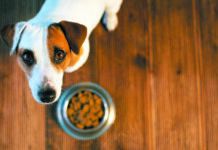Pyridoxine hydrochloride, poultry byproduct meal, DL-alpha-tocopherol acetate. No wonder some people get freaked when looking at the ingredients lists on dog food packages. The word combinations sounds straight out of a laboratory run by Jekyll and Hyde. A lot of customers would much rather see terms like “holistic” and “human grade.”
The thing is, words like “holistic” and “human grade,” which are often spread across the front of dog food packages in big, bold lettering, have no legal definition when it comes to provisions meant for pets. They mean whatever the manufacturer wants them to mean. Phrases like “DL-alpha-tocopherol acetate,” on the other hand, written in print that may require a magnifying glass, are the ones with legal heft. They have precise definitions that have to be adhered to in food manufacturing to help your dog maintain his health. That four-word tongue-twister beginning with “DL-alpha,” for instance, is a scientific way of signifying that the food inside the package has vitamin E activity, critical for a dog to remain in top shape, while “pyridoxine hydrochloride” stands for the presence of vitamin B6.
As for byproducts, people often remark that they are disgusting leftovers from food animals that humans would never eat, but that’s not true. Byproducts are simply the non-muscle meat of an animal, largely the organs, including the liver. And they are very rich in nutrients. The important thing is not the exact ingredient but the quality of that ingredient and the way it is formulated with other ingredients to meet all of a dog’s nutritional needs in the correct levels and proportions.
For some context, consider that ingredients used as byproducts in the United States are often considered delicacies elsewhere. Among them: tripe (cattle stomach), sweetbreads (thymus gland), and tongue. These items are prized for their taste in many nations, and even by some in our own country. That is, they are not simply cheap fillers.
Is it better if it’s “natural?”
By law, a “natural” dog food may not have any ingredients synthesized in a lab. But it is nearly impossible to meet all of a dog’s nutritional needs without at least some added vitamins and minerals; therefore, a truly “natural diet” is usually not nutritionally complete and balanced. In most cases, if a “natural diet” is made complete and balanced, the package will say something along the lines of “natural, with added vitamins, minerals, and other trace nutrients.”
What a “natural” dog food may not contain under any circumstances are synthetic, or laboratory-produced, preservatives. Lab-produced preservatives, which help food stay fresh, have been accused of causing everything from canine cancer to kidney disease to arthritis. The thing is, no proof of harm from synthetic preservatives has ever been scientifically documented. Even a synthetic preservative called ethoxyquin, which seems to cause the most concern for some dog owners who believe it will harm their pets, has never been found responsible for adverse health effects — not even in well-conducted studies in which high doses were fed to dogs.
To the contrary, preservatives — synthetic or natural — are critical for dry dog food. (The airtight storage that occurs in the canning process protects canned dog food from spoiling until it is opened.) Consider that dog food is relatively high in fat. Well, fat is the ingredient in food most susceptible to spoilage and very much in need of preserving. If fat does spoil, or oxidize, it not only decreases the nutritional quality of the food (some vitamins need fat to remain stable), it also makes it taste less palatable to the dog and, more importantly, can make the food unsafe to eat. After all, spoiled fat equals rancid fat.
Because synthetic preservatives have never been found to cause harm, we think worrying over them is unnecessary — and in some cases creates unnecessary difficulties. Consider that natural preservatives like vitamin C (which may be called ascorbic acid on an ingredients list), vitamin E (tocopherols), and rosemary are not as potent as synthetic ones, so their protection doesn’t last as long.
It’s not the end of the world for a preservative to be shorter-acting than its synthetic counterpart. In fact, if it makes you feel more comfortable, go ahead and choose dog food that has natural preservatives only rather than those that are man-made. But do try to buy smaller quantities than you would otherwise, and be sure to go through the food in short order rather than let it linger in your pantry or mudroom. Make sure the store from which you buy your dog food has good product turnover, too. These extra steps will help insure that your pet’s meals stay fresh as well as safe and healthful.




